|
(For a personal, detailed article see "H.M.A.S. Canberra and the Battle of Savo Island")
"My" Canberra
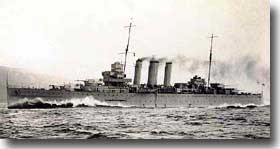 |
Chokai sighted Blue on her starboard bow at about 5 miles, the Japanese Navy was not fitted with radar at this stage, but they specially trained their lookouts, and used high powered very efficient night glasses to locate their enemy at long distances at night, and we had considered the Japanese vision to be totally inferior to that of Westerners.
Mikawa reduced speed to cut down the wake thrown up by his ships at high speed, held his fire, but he need not have worried, no action from Blue, who now reversed her course to steam away. Mikawa breathed freely once more.
The whole Japanese column passed by, very close to Blue, the eyes of the entire Japanese force upon the US destroyer, but not a peep from Blue, no visual sighting, no radar contact, nothing, just unbelieveable.
Jarvis, the US destroyer badly damaged earlier, was limping along at 10 knots, just south of Savo, making for Australia to execute repairs. At 0134, ( 1.34 AM ) she was sighted by Chokai only 1.5 miles away on her port bow.
Once more the Japanese force held their fire, wanting to maintain secrecy about their presence, they crept past, and Jarvis did not see a thing.
The next afternoon, Jarvis was caught by a large group of Japanese aircraft and promptly sunk.
At last, the gate was open for Mikawa, and with his column he sailed through, at 0136 ( 1.36 AM ) both Canberra and Chicago were sighted by the Japanese at a range of 6 miles.
On Canberra's bridge.
I had to call the Navigator at 0145 ( 1.45 AM ) and was very conscious of the time, he wanted to fix the ship's position just prior to the next scheduled course alteration at 0200 ( 2 AM ).
I had just checked the chart table clock at 0143 ( 1.43 AM ) suddenly a series of events crowded in on me, an explosion due north, ( most probably a Japanese torpedo blowing up at the end of its run, not having found a target ) the Captain was called. The port lookout reported sighting a ship ahead, no matter how hard I looked with my binoculars, nothing, neither could the PCO, nor the Yeoman of signals discern anything at all. Patterson, on our port bow signalling with a small blinker tube, we activated the action alarms. Patterson had in fact sighted the enemy, gave the alarm over her TBS ( talk between ships telephone ) " Warning! Warning! Warning! Strange ships entering harbour."
USS Patterson , Canberra's port escort at Savo
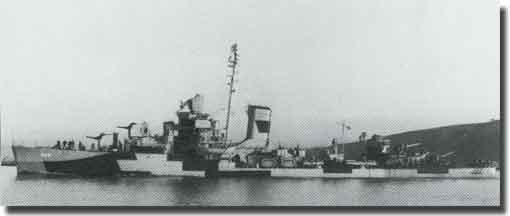 |
Canberra was not fitted with a TBS system, thus we did not receive that warning. It is quite amazing to think that there we were, in a desperate action situation, working with US Navy ships, one of our escorting destroyers sends out a vital message, and we cannot receive it because we have not been fitted with TBS equipment. Even at a distance of 60 years since Savo, I shake my head in disbelief!
But back to that awful night in question!
I quickly called the Captain, and the Navigating Officer, the PCO saw three ships on our starboard bow, gave the alarm, and ordered the 8 inch turrets to load. The Captain was the first on the bridge, I saw torpedo tracks approaching down our starboard side, the Captain ordered the engines full ahead, and starboard 35 degrees, to quickly swing the ship to starboard.
The Navigator had arrived, and told me " I have the Con." thereby relieving me from being the Officer of the Watch.
The Gunnery Officer took over from the PCO, and moved to the port Enemy Bearing Indicator ( this instrument is followed by the 8 inch Director, which in turn directs the main armament onto the same target delineated by the Gunnery Officer )
Further torpedo tracks were crossing our bows, ahead, starshell burst to light up the scene, and overhead aircraft dropped flares.
I hurried to my action station in the forecontrol overlooking the bridge, we were hit by a shell exploding on the 4 inch gun deck, and the Walrus aircraft was ablaze on its catapult. Another shell exploded on our port side just below the bridge, still another blew up just aft of my position, the plotting office was demolished. We were under severe fire from the Japanese heavy cruisers, I could see a large ship with a huge trunked funnel, no more than 3,000 yards away, blasting away. I recall muttering " My God! This is bloody awful!" I had been surrounded by incoming shells, but luckily remained unscathed.
Looking down onto the bridge, I could see absolute carnage, the shell bursting on the port side had demolished most of the bridge, the Gunnery Officer dead, decapitated, the Captain mortally wounded, with most of the other bridge officers wounded.
In the fore control, an able seaman standing alongside me had been struck down by a shell fragment, I gave him morphia, but he was a very sick young man.
The salvo of incoming shells had demolished both boiler rooms, there were no survivors, we lost all power, all steam, we did not, nor could not fire a shot.
The ship was listing noticeably to starboard, although only 2-3 minutes had elapsed, for Canberra, the war was over. We had picked up a torpedo on the starboard side, ( post war it was established that this fish was fired by our starboard escort destroyer USS Bagley.)
Chicago had about 16 feet of her bow blown away by a torpedo, she could still steam, and charged off to port, did not fire her main armament, fired off starshell from both her port and starboard 5 inch guns in the perceived direction of the enemy, none of these starshells functioned. Chicago did not send off any warning of the Japanese attack to the Northern Cruiser group.
USS Chicago damaged at Savo, but performed poorly in this battle
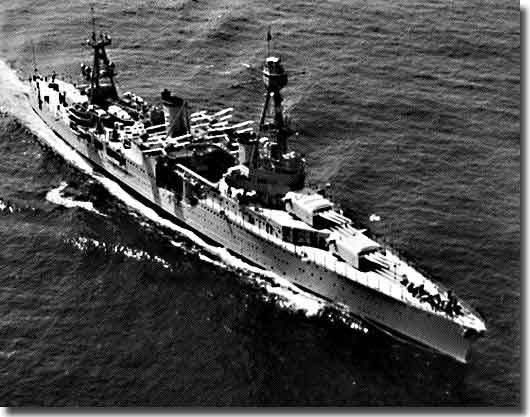 |
Patterson got off 50 rounds at the Japanese, but was herself hit, Bagley rushed off to the west, but Mikawa was long gone.
After demolishing Canberra, Mikawa divided his force into two groups, they swept past the Northern cruisers, and sank all three of them, his groups reformed as one, and quickly exited the scene at high speed for Rabaul and Kavieng.
On the way out, they came across Ralph Talbot, three cruisers engaged her, but she did not sink, escaping in a rain squall.
A small victory for the Allied cause, US Submarine S-44 caught Kako making for Kavieng, four torpedoes sent her to the bottom.
USS Quincy sunk at Savo
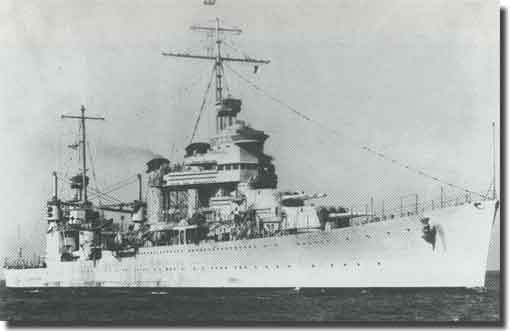 |
Back on board Canberra.
We were in a desperate position, fires above and below decks, nothing to fight them with, all the ships boats holed or destroyed, dead officers and sailors lying around, with many wounded wanting attention from a hard pressed medical team.
The ship listing to starboard, and at one stage looking as if she may roll over, we prepared to abandon ship, but she steadied and we stayed with her.
At about 0330 ( 3.30 AM ) Patterson came alongside our port side foreward, and we started to load the wounded into her, including Captain Getting. She provided pumps and hoses, and we started to fight the upper deck fires. Her Captain indicated that Turner said to inform us, if we could not steam by 0630 ( 6.30 AM ) Canberra would have to be abandoned, as he was withdrawing all the surface forces.
Suddenly, at 0430 ( 4.30 AM ) Patterson cut all lines, a ship had loomed up and opened fire, the destroyer also opened fire, then established it was the luckless Chicago, thinking she had found a Japanese ship on fire. At about 0630 ( 6.30 AM ) Patterson returned, and with Blue took off all of our survivors, we had 84 dead, and 109 more wounded. The US cruisers lost almost 1,000 personnel.
I went to the transport Fuller, and Patterson ferried her load of survivors to the transport Barnett.
USS destroyer Selfridge pumped 263 by 5 inch shells and fired 4 torpedoes at Canberra, the tough old ship refused to succumb, finally the US destroyer Ellet administered the coup-de-grace with one of her torpedoes fired amidships into her starboard side, and at 0800 ( 8 AM ) on the 9th. of August 1942, my ship finally slipped below the waves.
The entire surface force now withdrew, the Marines abandoned with but part of their equipment and food supplies unloaded.
Savo- Greatest US Navy Blue Water Defeat.
Savo was a bitter defeat for both the United States and Royal Australian Navies.
It was the greatest blue water defeat in the history of the USN.
For Mikawa, a stunning victory, but he faced criticism for not attacking the vulnerable transports, he feared air attack from the US carriers, and did not know that Fletcher had withdrawn.
Rear Admiral Turner's Flagship McCawley. It was on board that Turner, Crutchley and Van der Grift decided to withdraw all surface ships on August 9 1942 after the debacle of Savo
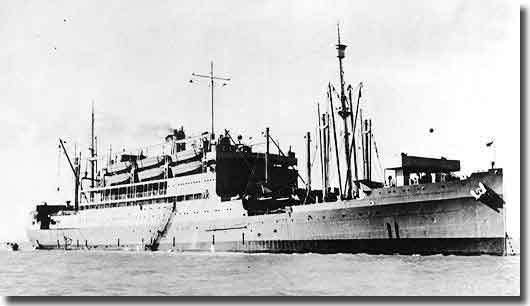 |
Captain Bode from Chicago
Captain Bode was criticised for not leading the Southern force when Crutchley departed in Australia to meet with Turner, and also for not warning the Northern cruisers, he was given a shore job, and later commited suicide by shooting himself.
Vice Admirals Ghormley and Fletcher.
Post Savo, both of these Vice Admirals were given shore positions. In November 1942, Fletcher became Commandant, Thirteenth Naval District, Seattle, Washington, and Commander Northwestern Sea Frontier. He was relieved as Commandant in October 1943, and later became Commander, Alaskan Sea Frontier, with additional duty as Commander North Pacific Force and North Pacific Ocean Area. A task force under his overall command on 4 February 1944 made the first sea bombardment of the Kurile Islands.
On a personal note, I have never forgiven Fletcher for leaving us without air cover after just two days, taking off his carriers meant Australia was not in the Southern group for Savo. Who knows? the outcome could have been quite different had she been present, leading the group.
Home, a Court of Enquiry, and two weeks survivor's leave.
Some weeks later I arrived in Sydney, faced a Court of Enquiry about the loss of Canberra, went on two weeks survivor's leave, rekitted, and was appointed to the old cruiser HMAS Adelaide, working in the Indian Ocean.

|